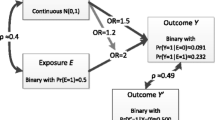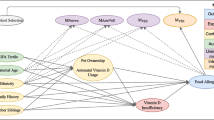Abstract
Purpose of Review
The setting of competing risks in which there is an event that precludes the event of interest from occurring is prevalent in epidemiological research. Unless studying all-cause mortality, any study following up individuals is subject to having a competing risk should individuals die during time period that the study covers. While there are prior papers discussing the need for competing risk methods in epidemiologic research, we are not aware of any review that discusses issues of missing data in a competing risk setting.
Recent Findings
We provide an overview of causal inference in competing risks as potential outcomes are missing, provide some strategies in dealing with missing (or misclassified) event type, and missing covariate data in competing risks. The strategies presented are specifically focused on those that may easily be implemented in standard statistical packages. There is ongoing work in terms of causal analyses, dealing with missing event type information, and missing covariate values specific to competing risk analyses.
Summary
Competing events are common in epidemiologic research. While there has been a focus on why one should conduct a proper competing risk analysis, a perhaps unrecognized issue is in terms of missingness. Strategies exist to minimize the impact of missingness in analyses of competing risks.

Similar content being viewed by others
References
Papers of particular interest, published recently, have been highlighted as: • Of importance, •• Of major importance
Cole SR, Lau B, Eron JJ, Brookhart MA, Kitahata MM, Martin JN, et al. Estimation of the standardized risk difference and ratio in a competing risks framework: application to injection drug use and progression to AIDS after initiation of antiretroviral therapy. Am J Epidemiol. 2015;181:238–45.
Schumacher M, Ohneberg K, Beyersmann J. Competing risk bias was common in a prominent medical journal. J Clin Epidemiol. 2016;80:135–6.
van Walraven C, McAlister FA. Competing risk bias was common in Kaplan-Meier risk estimates published in prominent medical journals. J Clin Epidemiol. 2016;69:170–173.e8.
Koller MT, Raatz H, Steyerberg EW, Wolbers M. Competing risks and the clinical community: irrelevance or ignorance? Stat Med. 2012;31:1089–97.
Austin PC, Fine JP. Accounting for competing risks in randomized controlled trials: a review and recommendations for improvement. Stat Med. 2017;36:1203–9.
Holland PW. Statistics and causal inference. J Am Stat Assoc. 1986;81:945–60.
Westreich D, Edwards JK, Cole SR, Platt RW, Mumford SL, Schisterman EF. Imputation approaches for potential outcomes in causal inference. Int J Epidemiol. 2015;44:1731–7.
White IR, Royston P. Imputing missing covariate values for the Cox model. Stat Med. 2009;28:1982–98.
Bartlett JW, Seaman SR, White IR, Carpenter JR, Alzheimer’s Disease Neuroimaging Initiative*. Multiple imputation of covariates by fully conditional specification: accommodating the substantive model. Stat Methods Med Res. 2015;24:462–87.
• Bartlett JW, Taylor JMG. Missing covariates in competing risks analysis. Biostatistics. 2016;17:751–63. This paper provides details on imputing covariates in a manner that is compatible with outcome model. Reference 9 provides context for understanding this paper.
Lau B, Cole SR, Gange SJ. Competing risk regression models for epidemiologic data. Am J Epidemiol. 2009;170:244–56.
Allignol A, Schumacher M, Wanner C, Drechsler C, Beyersmann J. Understanding competing risks: a simulation point of view. BMC Med Res Methodol. 2011;11:86.
Andersen PK, Geskus RB, de Witte T, Putter H. Competing risks in epidemiology: possibilities and pitfalls. Int J Epidemiol. 2012;41:861–70.
•• Austin PC, Fine JP. Practical recommendations for reporting fine-gray model analyses for competing risk data. Stat Med. 2017;36:4391–400. This review provides further view on how to interpret competing risk estimands as well as recommendations for reporting analyses.
Prentice RL, Kalbfleisch JD, Peterson AV, Flournoy N, Farewell VT, Breslow NE. The analysis of failure times in the presence of competing risks. Biometrics. 1978;34:541–54.
Fine JP, Gray RJ. A proportional hazards model for the subdistribution of a competing risk. J Am Stat Assoc. 1999;94:496–509.
• Latouche A, Allignol A, Beyersmann J, Labopin M, Fine JP. A competing risks analysis should report results on all cause-specific hazards and cumulative incidence functions. J. Clin. Epidemiol. 2013;66:648–53. This study provides recommendations on reporting competing risk analyses.
Andersen PK. Decomposition of number of life years lost according to causes of death. Stat Med. 2013;32:5278–85.
Cole SR, Hernán MA. Adjusted survival curves with inverse probability weights. Comput Methods Prog Biomed. 2004;75:45–9.
Xie J, Liu C. Adjusted Kaplan-Meier estimator and log-rank test with inverse probability of treatment weighting for survival data. Stat Med. 2005;24:3089–110.
Cole SR, Frangakis CE. The consistency statement in causal inference: a definition or an assumption? Epidemiology. 2009;20:3–5.
VanderWeele TJ. Concerning the consistency assumption in causal inference. Epidemiology. 2009;20:880–3.
VanderWeele TJ, Hernán MA. Causal inference under multiple versions of treatment. J Causal Inference. 2013;1:1–20.
Maldonado G, Greenland S. Estimating causal effects. Int J Epidemiol. 2002;31:422–9.
Hernán MA. A definition of causal effect for epidemiological research. J Epidemiol Community Health. 2004;58:265–71.
Hernán MA, Robins JM. Estimating causal effects from epidemiological data. J Epidemiol Community Health. 2006;60:578–86.
Bekaert M, Vansteelandt S, Mertens K. Adjusting for time-varying confounding in the subdistribution analysis of a competing risk. Lifetime Data Anal. 2010;16:45–70.
Cole SR, Hudgens MG, Brookhart MA, Westreich D. Risk. Am J Epidemiol. 2015;181:246–50.
• Lesko CR, Lau B. Bias due to confounders for the exposure-competing risk relationship. Epidemiol. 2017;28:20–7. First paper to illustrate that in a causal analysis, there is bias when not controlling for confounders of the exposure and competing event.
Edwards JK, Cole SR, Westreich D. All your data are always missing: incorporating bias due to measurement error into the potential outcomes framework. Int J Epidemiol. 2015;44:1452–9.
Greenland S, Pearl J, Robins JM. Causal diagrams for epidemiologic research. Epidemiology. 1999;10:37–48.
Hernán MA, Schisterman EF, Hernández-Díaz S. Invited commentary: composite outcomes as an attempt to escape from selection bias and related paradoxes. Am J Epidemiol. 2014;179:368–70.
Kramer MS, Zhang X, Platt RW. Kramer et al. respond to “composite outcomes and paradoxes”. Am J Epidemiol. 2014;179:371–2.
Rubin DB. Inference and missing data. Biometrika. 1976;63:581–92.
Edwards JK, Cole SR, Chu H, Olshan AF, Richardson DB. Accounting for outcome misclassification in estimates of the effect of occupational asbestos exposure on lung cancer death. Am J Epidemiol. 2014;179:641–7.
Grambauer N, Schumacher M, Dettenkofer M, Beyersmann J. Incidence densities in a competing events analysis. Am J Epidemiol. 2010;172:1077–84.
Goetghebeur E, Ryan L. Analysis of competing risks survival data when some failure types are missing. Biometrika. 1995;82:821–33.
Van Rompaye B, Jaffar S, Goetghebeur E. Estimation with cox models: cause-specific survival analysis with misclassified cause of failure. Epidemiol Camb Mass. 2012;23:194–202.
Nevo D, Nishihara R, Ogino S, Wang M. The competing risks Cox model with auxiliary case covariates under weaker missing-at-random cause of failure. Lifetime Data Anal. 2017; In Press
Lu K, Tsiatis AA. Multiple imputation methods for estimating regression coefficients in the competing risks model with missing cause of failure. Biometrics. 2001;57:1191–7.
Bakoyannis G, Siannis F, Touloumi G. Modelling competing risks data with missing cause of failure. Stat Med. 2010;29:3172–85.
Rubin DB. Multiple imputation for nonresponse in surveys. John Wiley & Sons; 2004.
Raghunathan TE, Lepkowski JM, Van Hoewyk J, Solenberger P. A multivariate technique for multiply imputing missing values using a sequence of regression models. Surv Methodol 2001;27:85–96.
van Buuren S. Multiple imputation of discrete and continuous data by fully conditional specification. Stat Methods Med Res. 2007;16:219–42.
Lau B, Cole SR, Moore RD, Gange SJ. Evaluating competing adverse and beneficial outcomes using a mixture model. Stat Med. 2008;27:4313–27.
Nicolaie MA, van Houwelingen HC, Putter H. Vertical modeling: a pattern mixture approach for competing risks modeling. Stat Med. 2010;29:1190–205.
Lau B, Cole SR, Gange SJ. Parametric mixture models to evaluate and summarize hazard ratios in the presence of competing risks with time-dependent hazards and delayed entry. Stat Med. 2011;30:654–65.
• Nicolaie MA, van Houwelingen HC, Putter H. Vertical modelling: analysis of competing risks data with missing causes of failure. Stat Methods Med Res. 2015;24:891–908. This study provides information on how to conduct competing risk analyses when which event occurred may be missing for some observations
Crowder MJ. Classical competing risks: CRC Press; 2001.
Neuhaus JM. Bias and efficiency loss due to misclassified responses in binary regression. Biometrika. 1999;86:843–55.
Carroll RJ, Ruppert D, Stefanski LA, Crainiceanu CM. Measurement error in nonlinear models: a modern perspective: CRC press; 2006.
Lyles RH, Tang L, Superak HM, King CC, Celentano DD, Lo Y, et al. Validation data-based adjustments for outcome misclassification in logistic regression: an illustration. Epidemiology. 2011;22:589–97.
Moons KGM, Donders RART, Stijnen T, Harrell FE. Using the outcome for imputation of missing predictor values was preferred. J Clin Epidemiol. 2006;59:1092–101.
van Buuren S, Boshuizen HC, Knook DL. Multiple imputation of missing blood pressure covariates in survival analysis. Stat Med. 1999;18:681–94.
Clark TG, Altman DG. Developing a prognostic model in the presence of missing data: an ovarian cancer case study. J Clin Epidemiol. 2003;56:28–37.
Barzi F, Woodward M. Imputations of missing values in practice: results from imputations of serum cholesterol in 28 cohort studies. Am J Epidemiol. 2004;160:34–45.
Seaman SR, Bartlett JW, White IR. Multiple imputation of missing covariates with non-linear effects and interactions: an evaluation of statistical methods. BMC Med Res Methodol. 2012;12:46.
Bartlett J, Keogh R. smcfcs: Multiple imputation of covariates by substantive model compatible fully conditional specification [Internet]. 2017 [cited 2017 Dec 9]. Available from: https://cran.r-project.org/web/packages/smcfcs/index.html
Funding
This work was supported by NIH grants U01 HL121812, U01 AA020793, P30 AI094189, and U24 OD023382.
Author information
Authors and Affiliations
Corresponding author
Ethics declarations
Conflict of Interest
Bryan Lau reports grants from NIH, during the conduct of the study.
Catherine Lesko declares no conflicts of interest.
Human and Animal Rights and Informed Consent
This article does not contain any studies with human or animal subjects performed by any of the authors.
Additional information
This article is part of the Topical Collection on Epidemiologic Methods
Rights and permissions
About this article
Cite this article
Lau, B., Lesko, C. Missingness in the Setting of Competing Risks: from Missing Values to Missing Potential Outcomes. Curr Epidemiol Rep 5, 153–159 (2018). https://doi.org/10.1007/s40471-018-0142-3
Published:
Issue Date:
DOI: https://doi.org/10.1007/s40471-018-0142-3




